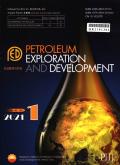Mechanisms of microbubble vibration in water-gas dispersion system enhancing microscopic oil displacement efficiency
IF 8
Q1 ENERGY & FUELS
引用次数: 0
Abstract
Two etching models, the spherical-rod standard pore channel and the pore structure, were used to conduct displacement experiments in the water-gas dispersion system to observe the morphological changes and movement characteristics of microbubbles. Additionally, numerical simulation methods were employed for quantitative analysis of experimental phenomena and oil displacement mechanisms. In the experiment, it was observed that microbubble clusters can disrupt the pressure equilibrium state of fluids within the transverse pores, and enhancing the overall fluid flow; bubbles exhibit a unique expansion-contraction vibration phenomenon during the flow process, which is unobservable in water flooding and gas flooding processes. Bubble vibration can accelerate the adsorption and expansion of oil droplets, and promote the emulsification of crude oil, thereby improving microscopic oil displacement efficiency. Combining experimental data with numerical simulation analysis of bubble vibration effects, it was found that microbubble vibrations exhibit characteristics of a sine function, and the energy release process follows an exponential decay pattern; compared to the gas drive front interface, microbubbles exhibit a significant “rigidity” characteristic; the energy released by microbubble vibrations alters the stability of the seepage flow field, resulting in significant changes to the flow lines; during the oil displacement process, the vast number of microbubbles can fully exert their vibrational effects, facilitating the migration of residual oil and validating the mechanism of the water-gas dispersion system enhancing microscopic oil displacement efficiency.
水气分散体系微泡振动提高微观驱油效率的机理
采用球棒标准孔道和孔结构两种蚀刻模型,在水气分散体系中进行位移实验,观察微气泡的形态变化和运动特征。采用数值模拟方法对实验现象和驱油机理进行定量分析。实验发现,微泡团簇可以破坏横向孔隙内流体的压力平衡状态,增强流体的整体流动;气泡在流动过程中表现出独特的膨胀-收缩振动现象,这在水驱和气驱过程中是无法观察到的。气泡振动可以加速油滴的吸附和膨胀,促进原油的乳化,从而提高微观驱油效率。结合实验数据和气泡振动效应的数值模拟分析,发现微气泡振动表现为正弦函数特征,能量释放过程遵循指数衰减模式;与气驱前界面相比,微气泡表现出明显的“刚性”特征;微泡振动释放的能量改变了渗流场的稳定性,导致渗流线发生显著变化;在驱油过程中,大量的微气泡可以充分发挥其振动效应,有利于剩余油的运移,验证了水气分散体系提高微观驱油效率的机理。
本文章由计算机程序翻译,如有差异,请以英文原文为准。
求助全文
约1分钟内获得全文
求助全文

 求助内容:
求助内容: 应助结果提醒方式:
应助结果提醒方式:


